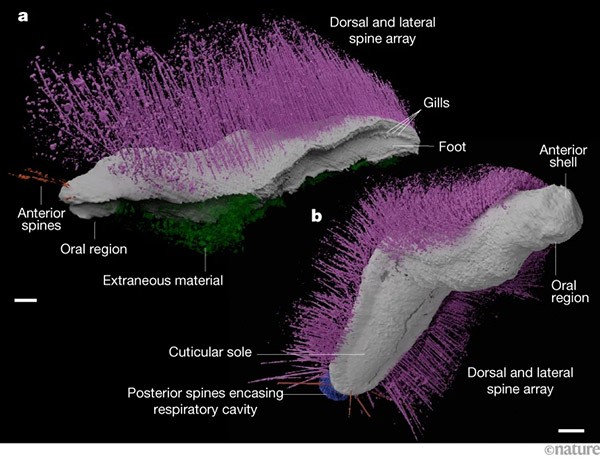Hello Nature readers, would you like to get this Briefing in your inbox free every day? Sign up here.

Particles known as fermions (illustration) can’t share the same state.Credit: Roman Andrade 3Dcienca/Science Photo Library
Theoretical physicists have proposed a new type of particle. This ‘paraparticle’ doesn’t fit into the conventional classification system that labels all subatomic particles either fermions or bosons. The study comes after another group recently provided the first experimental demonstration of an ‘anyon’, another kind of particle that doesn’t fit the fermion or boson mould, in a one-dimensional virtual universe. The unusual behaviour of paraparticles and anyons could one day play a part making quantum computers less error-prone.
Nature | 5 min read
Reference: Nature paper & Science paper
Scientists at the American Geophysical Union meeting in December tried to cool the debate about geoengineering — Earth-scale interventions to counter global warming — by outlining the priorities that should be considered before embarking on any large-scale projects.
• More modelling of the possible impacts of lofting particles into the atmosphere to reflect sunlight and of methods to brighten clouds.
• Widespread assessment of the risks of geoengineering to biodiversity, weather and human health.
• Movement in gridlocked international negotiations to agree on global standards and stop the current free-for-all in which a handful of start-ups have kicked off artificial-cooling campaigns without any oversight.
Nature | 5 min read
Blood vessel contractions co-ordinated by regular spikes of an adrenaline-adjacent hormone help to ‘wash’ the brains of mice while they sleep. Scientists think that during sleep, the brain’s waste disposal system — the glymphatic system — flushes cerebrospinal fluid through the brain to clear out any unwanted chemicals. By studying sleeping mice, scientists noticed that levels of norepinephrine in the mice’s brains yo-yo in the non-REM sleep phase, which causes blood vessels to contract in the same rhythm. The team suggests that this pushes cerebrospinal fluid through the brain like a pump, which picks up lingering molecules as it goes.
Science | 5 min read
Reference: Cell paper
Features & opinion
Modifying multiple DNA variants in human embryos at the same time, a process called polygenic genome editing, could substantially reduce the likelihood of certain diseases occurring. But it also raises concerns, say the authors of a Nature analysis — not least the renewed threat of eugenics. “This is not a hypothetical issue,” argues an accompanying Nature editorial. While such genome editing might be decades off, societies need to consider its possible benefits and risks now to avoid having to play regulatory catch-up when the technology becomes available.
Nature | 4 min read
Reference: Nature paper
When neuroscientist Jeff Yau started experiencing numbness, tingling and shaking in his hands and feet shortly after he got COVID in 2022, it led to a diagnosis of an autoimmune disorder called chronic inflammatory demyelinating polyneuropathy (CIDP). But the standard treatments for it didn’t work. So Yau turned to his scientific colleagues for help in finding clues to what might be going wrong — leading to the discovery that the cause was a specific type of antibody attacking his nerve tissue. Yau’s symptoms are now improving. “It was comforting,” he says, “to be able to say: science works, science makes sense. And now that we know this, what is the next step?”
You Can Know Things blog | 7 min read
In the past two decades, public-health programmes across Africa have resulted in a 97.5% reduction in cases of human African trypanosomiasis, commonly known as sleeping sickness. Efforts to control the population of the tsetse fly, which transmit the parasites that cause the disease to humans, and the development of more-effective therapies have brought us to the brink of eliminating the once-widespread disease. But the parasites, Trypanosoma brucei gambiense and Trypanosoma brucei rhodesiense, are masters at learning how to evade the immune system and treatments. “If we stopped now, sleeping sickness would come back, and it could affect millions of people,” says the World Health Organization’s Gerardo Priotto.
Nature | 12 min read
This editorially independent article is part of Nature Outlook: Neglected tropical diseases, a supplement funded by a grant from Merck Sharp & Dohme and with financial support from Moderna.
Image of the week

Meet Punk and Emo, virtual reconstructions of two approximately 430-million-year-old mollusc fossils. Punk ferox (a) was named after its spiky ‘hairstyle’ and Emo vorticaudum (b) after two stud-like shells on its upper surface and shorter spines that echoes a fringe. Neither mollusc resembles a mollusc group that has previously been described, or each other, hinting that early molluscs were far more diverse than we knew. (Nature | 6 min read)
Reference: Nature paper
Go deeper into how species get their interesting names — and sometimes, their problematic ones — in Nature’s podcast series, ‘What’s in a name’. (Sutton, M. D. et al./Nature (CC BY 4.0))
Today I’m rooting for Rye, a golden retriever sniffing out species of truffle in rural Oregon. Rye’s owner, biologist Heather Dawson, is using her furry friend’s gift for rooting out a variety of different truffle species to collect data on their diversity and distribution in the Western state, some of which she has published.
Help us root out any issues with this newsletter by sending your feedback to [email protected].
Thanks for reading,
Jacob Smith, associate editor, Nature Briefing
With contributions by Flora Graham and Katharine Sanderson
Want more? Sign up to our other free Nature Briefing newsletters:
• Nature Briefing: Careers — insights, advice and award-winning journalism to help you optimize your working life
• Nature Briefing: Microbiology — the most abundant living entities on our planet — microorganisms — and the role they play in health, the environment and food systems
• Nature Briefing: Anthropocene — climate change, biodiversity, sustainability and geoengineering
• Nature Briefing: AI & Robotics — 100% written by humans, of course
• Nature Briefing: Cancer — a weekly newsletter written with cancer researchers in mind
• Nature Briefing: Translational Research — covers biotechnology, drug discovery and pharma






